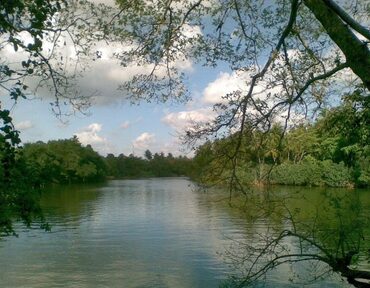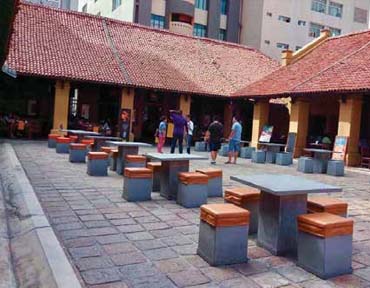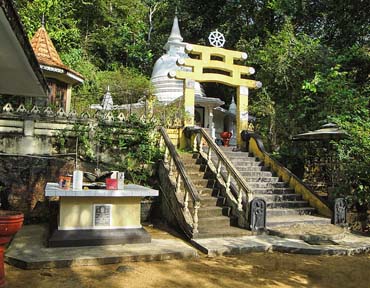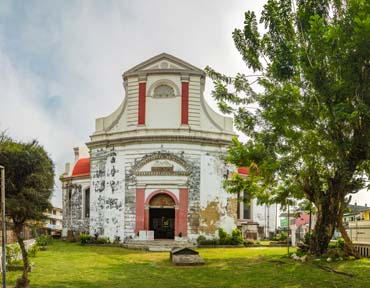


The Kelani River (කැළණි ගඟ) is a 145-kilometer-long (90 mi) river in Sri Lanka. It ranks as the fourth-longest and one of the main rivers in the country, originated from the Sri Pada Mountain Range to Colombo. Along its course, it passes through or borders several Sri Lankan districts, including Nuwara Eliya, Ratnapura, Kegalle, Gampaha, and Colombo itself. The Kelani River has two main tributaries in its upper reaches: the Kehelgamu Oya and the Maskeli Oya. These tributaries contribute to hydroelectric production in Sri Lanka, with major reservoirs and power stations along their course. Notable reservoirs include Castlereigh Reservoir, Norton Reservoir, Maskeliya Reservoir, Canyon Reservoir, and Laxapana Reservoir. The Kelani River supplies approximately 80% of the water used in Colombo, making it crucial for the capital city. Beyond drinking water, the river serves transportation, fisheries, and hydroelectricity production.

The Old Colombo Dutch Hospital (known as The Dutch Hospital) is considered to be the oldest building in the Colombo Fort area dating back to the Dutch colonial era in Sri Lanka. It is now a heritage building and a shopping and dining precinct. Built as a hospital by the Dutch, it has been used for several different purposes, over the years. It is believed to have existed since 1681, as recorded by German Christoper Schweitzer. The Dutch established the Colombo hospital to look after the health of the officers and other staff serving under the Dutch East India Company. The hospital’s close proximity to the harbour allowed it to serve Dutch seafarers. The most famous of all the surgeons who worked in the Colombo hospital was undoubtedly Paul Hermann, who served from 1672-79. Herman has been described as the father of botany in Sri Lanka.

The religious history of Sri Lanka is the largest part of Sri Lankan history that deeply embedded into its culture and shaping the traditions norms and giving the inhabitants of the country the well founded calmness, serenity, the proudness and the sense of belonging in the modern era. Illustrating the spiritual aspects, showcasing the physical evidences of religions and their history is a intrinsic part of a highly unique heritage. And monasteries falls into such proud heritage where spiritual aspects of religions transcends the entire civilizations, in thus giving the monastery be the living proof of such tranquil heritage where spirituality and self actualization as well as personal enlightenment were not mere dreams. Transcending the natural world to accommodate the needs of humanity still while preserving the sustainability and maintaining well balanced natural adoption into a peaceful eco-system as well as still walking on the path of seeking the inner peace, the Monasteries are the best ever integration between the humanity inside a natural world, in architectural designs or otherwise. Madakada monastery or Madakada Aaranya Senasanaya is one of the best interconnected path of humanity and nature. Madakada Aaranya not only illustrating the tranquility of Buddhism but also welcomes the humanity into its embrace with open arms disregarding the barriers of humanity that device them from each other and the nature itself. Under the vibrant greenery of the forest safely tucked away and opened to anyone and everyone a silent gateway to illustrate the path to transcends, the Madakada Monasteries is a true relic of the Buddhist civilizations giving away the roots of spiritual tranquility. Nestle inside the forest at Ingiriya of Kaluthara District the Madakada Monastery is also famous for its name as Nachchimale Manastry, housing the ideal background with forest reserve, the rhythmic stream of water flow of a nearby branch cannel named Nambapana Ala, or also known as Nachchimale Dola, the gently swaying leaves of the trees and hosting over playful wind current has given the Ambiance to this area with its huge Flora and fauna seeking refuge, is one of the greatest destination if one is searching for the tranquility of mind.

Wolvendaal Church (Wolvendaalse Kerk) is a remarkable Dutch Colonial-era building located in the Pettah neighborhood of Colombo. In 1736, Governor Gustaaf Willem van Imhoff sought approval from the Dutch East India Company (VOC) to demolish the existing church (Kasteel Kerk) within Colombo Fort and construct a new one on the same site. The VOC initially refused, but Governor Julius Valentyn Stein van Gollenesse resolved the impasse. The new church was erected beyond the city walls in an area known as Wolvendaal (Wolf's Dale or Wolf's Valley). The site was chosen for its commanding views across the town, proximity to the entrance, and historical significance. Constructed in the Doric style, the church forms a Greek cross with walls nearly 1.5 meters (five feet) thick. It is made of large kabok (clay ironstone) mixed with coral and lime plaster. The high roof resembles a dome and was originally arched with brick, covered in blue Bangor slate roof tiles. Atop the dome stood a brazen lion symbolizing the seven united provinces of the Dutch Republic. Unfortunately, in 1856, lightning destroyed the lion and damaged the dome. Completed on March 6, 1757, the Wolvendaal Church remains one of the oldest Protestant churches still in use in Sri Lanka.